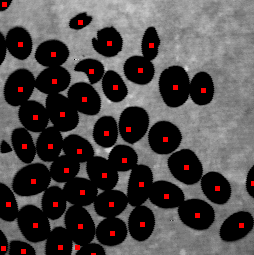Counting Coffee Beans
This example demonstrates how to use intensity thresholding and morphological operators to separate and count coffee beans.
It was originally published on Stack Overflow. Check out the detailed explanation:
"Coffee beans separation algorithm" Input Image:


import static marvin.MarvinPluginCollection.floodfillSegmentation; import static marvin.MarvinPluginCollection.thresholding; import marvin.image.MarvinColorModelConverter; import marvin.image.MarvinImage; import marvin.image.MarvinSegment; import marvin.io.MarvinImageIO; import marvin.math.MarvinMath; import marvin.plugin.MarvinImagePlugin; import marvin.util.MarvinPluginLoader; public class CoffeeBeansSeparation { private MarvinImagePlugin erosion = MarvinPluginLoader.loadImagePlugin("org.marvinproject.image.morphological.erosion.jar"); public CoffeeBeansSeparation(){ // 1. Load Image MarvinImage image = MarvinImageIO.loadImage("./res/coffee.png"); MarvinImage result = image.clone(); // 2. Threshold thresholding(image, 30); MarvinImageIO.saveImage(image, "./res/coffee_threshold.png"); // 3. Segment using erosion and floodfill (kernel size == 8) List<MarvinSegment> listSegments = new ArrayList<MarvinSegment>(); List<MarvinSegment> listSegmentsTmp = new ArrayList<MarvinSegment>(); MarvinImage binImage = MarvinColorModelConverter.rgbToBinary(image, 127); erosion.setAttribute("matrix", MarvinMath.getTrueMatrix(8, 8)); erosion.process(binImage.clone(), binImage); MarvinImageIO.saveImage(binImage, "./res/coffee_bin_8.png"); MarvinImage binImageRGB = MarvinColorModelConverter.binaryToRgb(binImage); MarvinSegment[] segments = floodfillSegmentation(binImageRGB); // 4. Just consider the smaller segments for(MarvinSegment s:segments){ if(s.mass < 300){ listSegments.add(s); } } showSegments(listSegments, binImageRGB); MarvinImageIO.saveImage(binImageRGB, "./res/coffee_center_8.png"); // 5. Segment using erosion and floodfill (kernel size == 18) listSegments = new ArrayList<MarvinSegment>(); binImage = MarvinColorModelConverter.rgbToBinary(image, 127); erosion.setAttribute("matrix", MarvinMath.getTrueMatrix(18, 18)); erosion.process(binImage.clone(), binImage); MarvinImageIO.saveImage(binImage, "./res/coffee_bin_8.png"); binImageRGB = MarvinColorModelConverter.binaryToRgb(binImage); segments = floodfillSegmentation(binImageRGB); for(MarvinSegment s:segments){ listSegments.add(s); listSegmentsTmp.add(s); } showSegments(listSegmentsTmp, binImageRGB); MarvinImageIO.saveImage(binImageRGB, "./res/coffee_center_18.png"); // 6. Remove segments that are too near. MarvinSegment.segmentMinDistance(listSegments, 10); // 7. Show Result showSegments(listSegments, result); MarvinImageIO.saveImage(result, "./res/coffee_result.png"); } private void showSegments(List<MarvinSegment> segments, MarvinImage image){ for(MarvinSegment s:segments){ image.fillRect((s.x1+s.x2)/2, (s.y1+s.y2)/2, 5, 5, Color.red); } } public static void main(String[] args) { new CoffeeBeansSeparation(); } }